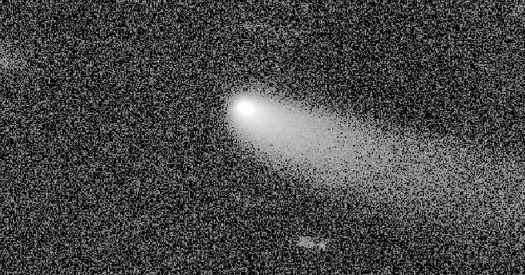As Douglas Adams once said: Space is big. Really big. Consequently, scientists see only tiny slivers of space at any given moment, so on those infrequent occasions when something new is observed, it’s a revelatory delight.
Astronomers recently witnessed an enigmatic icy object in Jupiter’s shadow begin its transformation into a type of comet, one that sticks close to the sun. It’s the first time they’ve watched this happen.
The object, named LD2, is called a Centaur, an icy proto-world named after mythological part-person, part-horse creatures because these orbs can behave like an asteroid and a comet. Centaurs hang out between Jupiter and Neptune. Constantly pulled at by the gravity of the gas and ice giants, they are usually either expunged from the solar system, or they are thrown toward the sun. In that case, they become hyperactive comets, orbiting the sun along a highly elliptical racetrack that doesn’t extend too far beyond Jupiter.
According to a study published last month in The Astrophysical Journal Letters, the chaos of this gravitational battle royale has determined that LD2 is going to set up shop in the inner solar system. Forty-three years from now, this Centaur’s transition will be complete. It will be fizzing and bubbling as it is braised by the sun, becoming the newest member of the so-called Jupiter Family of Comets.
The migration of comets and soggy asteroids from the fringes of our stellar neighborhood toward the rocky inner worlds was like a water delivery service in the early days of the solar system, slaking the thirst of planets drying out because of giant impacts and planetwide magma oceans. LD2’s encroachment will allow astronomers to see what happens when a pristine icy object makes a daring dive toward the sun, providing an enlightening echo of eras past.
Meg Schwamb, an astronomer at Queen’s University Belfast who was not involved with the study, said that scientists tended to get only snapshots of space phenomena. This time, we get to see an entire cosmic process play out from start to end. “We have a front-row seat,” she said. “You can get your popcorn out.”
Many millions of years ago, LD2 was an icy object beyond Neptune’s orbit. The planet’s gravity ensnared it and brought it into the space between Jupiter and Neptune.
In 2019, the Asteroid Terrestrial-impact Last Alert System or ATLAS, a pair of NASA-funded telescopes developed by the University of Hawaii that search for potential city-killing and country-crushing space rocks, spotted an object that appeared to be tracing Jupiter’s orbital path. Astronomers named it P/2019 LD2, or LD2 for short.
On closer inspection, its orbit was found to be suspiciously wobbly. Orbital calculations suggest that it got a bit too close to Jupiter’s massive gravitational force in 2017. Like a cyclist going around a velodrome encountering a sudden steep drop, LD2 was thrown off-balance, putting it on course to fall toward, and ultimately remain mostly within, the inner solar system.
It was also found to be rather excitable: Astronomers could see escaping icy matter forming a hazy cloud called a coma, and a tail rocketed out into the inky beyond. But its coma lacks water vapor, said Teddy Kareta, a planetary astronomy graduate student at the University of Arizona and co-author of the study. Combined with models of its orbital evolution, this suggests LD2 has not yet visited the inner solar system. Scientists caught it just as it started its first journey into the warmer region around our sun.
By 2063, LD2 will be shooting around our local star at breakneck speeds, completing one orbit roughly every six years. Being close enough to the sun, its water ice will be persistently obliterated, fueling a water vapor coma. “And water-driven activity is usually what we think of as a comet,” said Jordan Steckloff, a research scientist at the Planetary Science Institute in Tucson, Ariz., and the study’s lead author.
Considering the epic length of astronomical time scales, LD2’s fleeting saga is unusual. Its evolutionary journey is happening in lock step with our day-to-day existence. A young astronomer can follow its entire transition, from youth to cometary adulthood, and still be alive at its conclusion.
LD2’s ephemerality isn’t lost on scientists. “To see something that’s so short-lived, that’s changing — it’s a reminder that the solar system is dynamic,” Dr. Schwamb said. “It is a changing being, in some sense, just like us.”
Exploring the Solar System
A guide to the spacecraft beyond Earth’s orbit.
Sync your calendar with the solar system
Never miss an eclipse, a meteor shower, a rocket launch or any other astronomical and space event that's out of this world.
Source: Read Full Article


